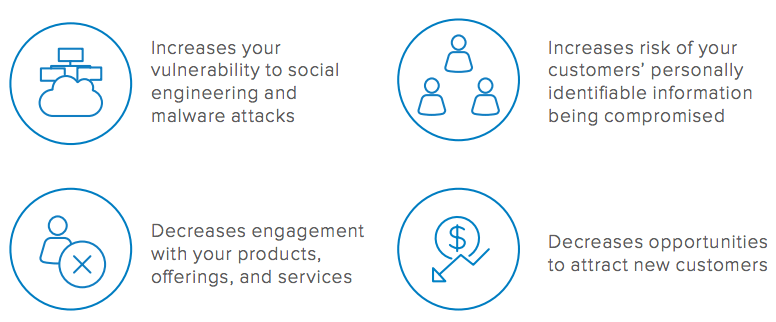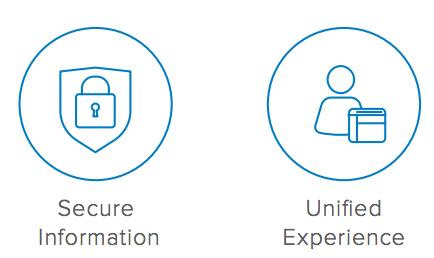Building Seamless Experiences for Financial Services Customers
Executive Summary
Digital transformation has become a modern business imperative. Today’s consumers are more tech-savvy than ever, and expect rich, meaningful digital engagement with the financial institutions, products, and services they interact with.
To attract such engagement from customers in return, financial service providers should work towards providing
a frictionless user experience. A dedicated digital strategy can empower this in many ways—from making information available and easy to access, to ensuring a consistent login experience across multiple platforms and strengthening the authentication process. As financial companies leverage more digital tools and cloud solutions, there’s great potential to deliver experiences to customers that are more efficient, and ultimately, more enjoyable.
But those experiences require trust, something that is not always easily gained. The finance industry is one of the biggest targets of cybercrime, and such attacks cost the sector an average of $18.28 million annually—the highest of all industries. Now that data breaches and security incidents are intense fixtures in the media, customers are increasingly reluctant to share information and engage meaningfully.
Financial services need to be proactive if they are to regain this fading trust—and seizing control of identity offers a unique opportunity to do so. By crafting a forward-thinking identity strategy, financial institutions can restore consumer confidence by better securing information and delivering a stronger customer experience.
Trust Is Paramount to Customer Experiences
In an ever more competitive business climate, superior customer engagement through digital channels present a unique opportunity for differentiation. In fact, 76% of recently surveyed executives identify digital transformation as a critical or very important priority.
Financial players must engage customers with reassuring and reliable communications around security practices— but they cannot do this without first taking internal action. Leaders in many industries are taking strides towards digital transformation, and the finance industry must likewise advance its technologies and processes to retain customer loyalty.
While financial customers are eager to engage digitally, they often exercise caution. After all, their security concerns are justified: data breaches are everywhere, and it’s little secret that identity and access issues are usually the root cause.
•81% of breaches involve stolen or weak credentials
•91% of attacks target credentials
•73% of passwords are duplicates
A number of security issues arise from credential harvesting. First, contextual information gained can increase customer exposure to social engineering and malware attacks. This increases the risk of personally identifiable information being compromised, which can have grave results:
•Customers developing a lack of confidence in the ability of financial institutions to keep their information safe. When confidence is low, it leads to a number of issues that impede digital transformation initiatives.
•Customers switching to competitors. With so many competing financial service providers, if confidence in an institution is already beyond repair, there’s little to stop customers from switching to one that inspires greater trust and will provide them with a better user experience.
•Customers reusing passwords. With so many different services asking the same consumer for a login and password, people may be easily tempted to use the same credentials with their financial accounts. This is a dangerous practice—all it takes is one breach to jeopardize a customer’s finances and personal information.
Frictionless customer experiences go a long way towards building customers’ confidence in an organization’s ability to keep sensitive information safe. When customers know they can expect a unified, personalized, and seamless brand experience, they are more likely to engage with financial institutions across a number of platforms and channels, thus facilitating and encouraging further customization and digitization across the business.
Poor Security, Poor Engagement: A Vicious Cycle

Ultimately, trust issues damage a business. They make it difficult to engage with customers, and make customers less willing to consume your product and services. Consequently, this makes it difficult to capitalize on revenue opportunities.
Without trust, there is no data, and without data, there is no customer value. When businesses fail to deliver value, customers are even less likely to trust them, and many organizations get trapped in a vicious cycle.
Identity: The Foundation of a Customer Experience
The good news is that while mistrust creates a vicious cycle, trust creates a virtuous cycle. When customers trust the companies that manage their money, it motivates them to engage more, which allows financial services providers to deliver more value, which in turn makes customers even more willing to trust the institution with their personal and business finances.
The key to restoring that trust is to excel at understanding, managing and securing customer identity. A strong identity management strategy allows organizations to:
•Secure customer information. A modern, coordinated identity management strategy helps to drastically mitigate many of the vulnerabilities discussed earlier. Financial institutions need to earn their customers’ trust with a proven security solution. Individuals and companies are more likely to engage if they know their information is protected—and if their trust is lost, it’s probably gone for good.
•Deliver seamless, branded experiences. A highly coordinated identity strategy helps financial firms build customer experiences across brands and product/service lines. Experiences can be highly integrated and personalized, which means better loyalty and satisfaction; having a global identity layer and standards-based authorization can unify access and experiences across applications and engagement points with a customer.
Why Okta?
Okta’s approach to identity and access management is uniquely positioned to help financial institutions take control across these three pillars of value.

Securing customer information
•Secure personally-identifiable information in a modern, hardened cloud service with best-in-class security controls designed and built in.
•Ensure federal financial compliance and regulations are met across the board.
•Deliver secure sign-in with powerful options for single sign-on and multi-factor authentication. It is unrealistic for customers, clients, and partners to remember dozens of strong passwords in order to access their accounts and services. Okta takes human error out of the picture.
•Manage complex authorization across users, apps, and APIs, allowing you to reduce the possibility of cross-site attacks and increasing the value delivered through unified experiences, whether a customer is interacting on an app or desktop.
•Unify your customer identity infrastructure into a single service. Financial institutions, especially large ones, are notorious for information silos that create room for error and needless complexity—the enemy of security.
Delivering a branded, scalable user experience
•Design and build applications that enable a broader set of engagement points with your customers
•Out-of-box, market-leading global identity layer and standards-based authorization that unifies access and experiences across engagement points.
•Deliver customizable, branded customer experiences that are streamlined and efficient, but also lead to deeper insight and customer satisfaction.
•Easily manage account provisioning for all your customers, clients, and partners, and automate user lifecycles. This enables end-to-end control over the whole customer experience, and streamlines the process of opening and closing accounts.
•Differentiate your brand as you continue to roll out high value service offerings through digital channels. The financial sector is competitive, and businesses work hard and find ways to set themselves apart.
We are Here to Help
Okta provides an end-to-end solution for modern identity management. We connect with complex service infrastructures, enrich context by providing threat intelligence to deploy single sign-on, multi-factor authentication, and automate lifecycle management. We do all of that by working with your existing security infrastructure to provide better service to you and your customers.